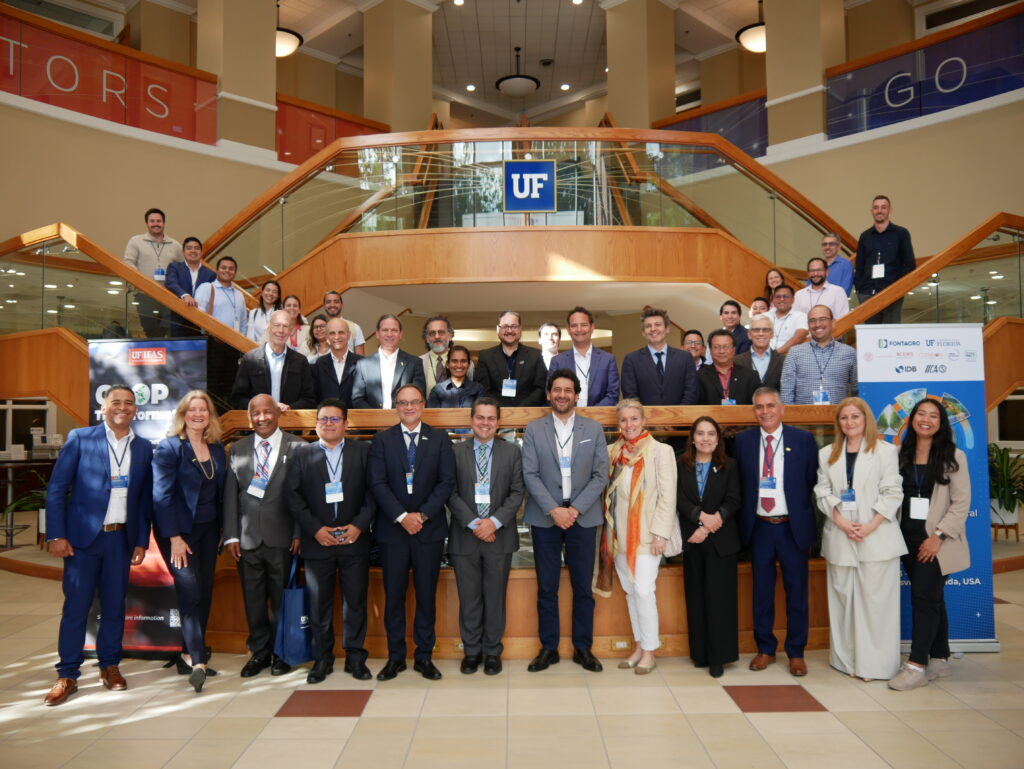
During the prominent workshop titled “Strategic Dialogues for the Future: Advancing Agricultural Science to Deliver Societal Value in LAC and the U.S.”, co-organized by FONTAGRO, the University of Florida, and the Inter-American Institute for Cooperation on Agriculture (IICA), more than 80 participants gathered at the University of Florida in Gainesville from May 13 to 15, 2025. Under the leadership of FONTAGRO’s Board of Directors, the event brought together representatives from various disciplines, including academics, business people, and funding organizations, focusing on crucial topics such as sustainability, technological innovation in agriculture, and the future of food production.
This event reaffirms FONTAGRO’s commitment to investing in research, development, and innovation in the agri-food sector through the creation of public-private institutional ecosystems. During this strategic meeting, the design phase of FONTAGRO’s Medium-Term Plan 2025-2030 was initiated, in collaboration with leading institutions such as the University of Florida, Clemson University, Cornell University, North Carolina State University, The Ohio State University, Meat Institute, ICARDA; International Center for Agricultural Research in the Dry Areas, the Inter-American Development Bank, the World Bank, the Inter-American Institute for Cooperation on Agriculture (IICA), the Development Bank of Latin America (CAF), Corteva Agriscience, Western Growers Center for Innovation & Technology, GRUPO CAJAMAR, Embrapa, the GAP Initiative at Virginia Tech, and UF Innovative. Discussions focused on identifying investment priorities in R&D&I for the agri-food sector, both regionally and globally, based on the main short- and medium-term trends in key scientific areas for agriculture and food development.

The flagship programs of FONTAGRO discussed during the event will focus on various areas, such as:






We express special thanks to the University of Florida, particularly its Institute of Food and Agricultural Sciences, as well as to all the institutions that made this event possible. We also extend our gratitude to the National Research Institutes, represented by their directors: INTA Argentina, INIAF Bolivia, INIA Chile, AGROSAVIA Colombia, INTA Costa Rica, INIAP Ecuador, INIA Spain, DICTA Honduras, INTA Nicaragua, IDIAP Panama, IPTA Paraguay, INIA Peru, IDIAF Dominican Republic, INIA Uruguay, and INIA Venezuela.

Learn more at: https://digital.fontagro.org/en/medium-term-plan-2025-2030-en/
***
About FONTAGRO
FONTAGRO was created 1998 with the purpose of promoting the increase of the competitiveness of the agri-food sector, ensuring the sustainable management of natural resources and the reduction of poverty in the region. The objective of FONTAGRO is to establish itself as a sustainable financing mechanism for the development of agricultural technology and innovation in Latin America and the Caribbean and Spain, and to establish a forum for the discussion of priority topics of technological innovation. The member countries are: Argentina, Bolivia, Chile, Colombia, Costa Rica, Ecuador, Spain, Honduras, Nicaragua, Panama, Paraguay, Peru, Dominican Republic, Uruguay and Venezuela. In the last 27 years 204 regional agricultural innovation platforms have been co-financed for an amount of US $ 150.7 million, which has reached 531 institutions and 35 countries worldwide.
